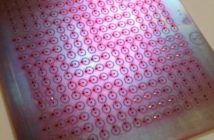Researchers engineered disposable yeast badges that are capable of tracking daily radiation exposure, according to a study published on August 9, 2018.
This study was conducted by the researchers at the Purdue University. These disposable badges were made of freezer paper, aluminum, and tape. A drop of water will activate the yeast to show radiation exposure as read by an electronic device. The readout device, on a commercial level, could one day be a tablet or phone. The badge could also be adapted in the future for nuclear power plant workers and victims of nuclear disasters.
Radiology workers are regularly exposed to low doses of radiation when they obtain patient imagery, such as X-rays. While protective gear largely keeps workers within a safe range of radiation exposure, absorbing a little bit is still inevitable. The success of the badge lies in the quick and measurable response of yeast to radiation: The higher the radiation dose, the higher the percentage of yeast cells that die. Wetting the badge activates the cells that are still alive to eat glucose and release carbon dioxide.
Rahim Rahimi, Purdue postdoctoral researcher in electrical and computer engineering, said, “We use the change in electrical properties of the yeast to tell us how much radiation damage it incurred. A slow decrease in electrical conductivity over time indicates more damage.” The numbers obtained from the readout system is translated to rads, which are units used by entities such as the Occupational Safety and Health Administration. This is done to specify limits on how much radiation human tissue can safely absorb. Moreover, yeast is known to be genetically similar to human tissue. Therefore, data from the badges can inform future work on how radiation damage happens to human DNA and proteins.

